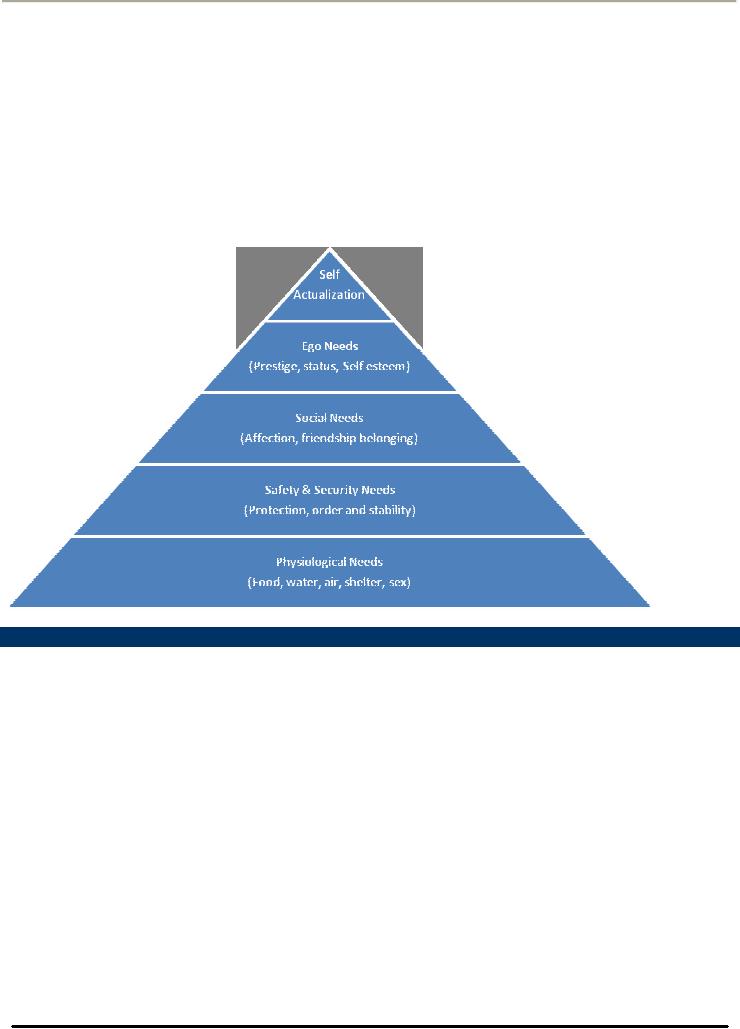 |
CONSUMER MOTIVATION:Needs, Goals, Generic Goals |
| << CONSUMER PERSONALITY, TRAIT THEORY AND SELF IMAGES |
| UNDERSTANDING LEARNING:Intentional and Incidental Learning, Implications for Marketers >> |

Consumer
Psychology (PSY -
514)
VU
LESSON30
CONSUMER
MOTIVATION
CHAPTER
5: INDIVIDUAL DETERMINANTS OF CONSUMER
BEHAVIOR
Understanding:
�
Motivation
as a Psychological Force
�
Needs
�
Goals
�
Positive
& Negative Motivation
�
Rational
vs. Emotional
Motivation
�
Types
and systems of Needs
�
Hierarchy
of Needs Motivation
Consumer
Motivation
Savvy
companies define their
missions in terms of consumer
needs they satisfy rather than the
products they make
and
sell. Consumers basic needs
do not change but the products
that satisfy them do. Corporate
focus on
developing
products that will satisfy
consumer's needs ensures
that the company stays in the
forefront of the
search
for new and effective
solutions
Charles
Revson was the builder of a
Cosmetic Empire (Revlon). He started by
manufacturing the nail polishes.
He
did
so but first changed the
definition of the nail polish
for himself and for his
consumers. His Nail
polish
definition:
Nail
Polish is a fashion accessory, not merely
a nail covering. Revson's Philosophy:
Induce
women to
use
different shades of nail
polish to match different
outfits, moods and
occasions. Result:
Women
started buying
and
using many different colors
of nail polishes the same
season rather than waiting for the
bottle to end to buy
one
more and market vastly
broadened for the product.
Revson started introducing
new nail colors every
fall and
spring.
He used some heavy and
effective advertising to persuade women
that buying new colors
would satisfy
their
needs to appear fashionable
and attractive. Consequently he developed
separate cosmetic lines
targeting
different
consumer segments. Natural Wonder:
Targeting the Youth Market. Marcella
Borghese: High-class
line
with
international flavor. Fire
and Ice: Deep red polish.
Revson
understood that he was not
selling women the nail
polish but fantasies that
nail polish would
attract
attention
and bestow class and glamour
upon the user.
Motivation
in the context of consumers may be
best understood with the help of
following concepts:
1.
Positive/Negative Motivation
Driving
force towards some object or condition is
positive motivation. Driving force
away from some object
or
condition.
Some psychologists refer to positive
drives as needs, wants or
desires. Negative drives as
fears or
aversions.
Even though the positive and
negative drives seem to
differ dramatically in terms of
physical and
sometimes
emotional activity, they are
similar in that they both
serve to initiate and
sustain human
behavior
Approach
object: is a
positive goal towards which
the behavior id directed and
Avoidance
object is a
negative
goal
from which the behavior is
directed away.
2.
Rational and Emotional
Motivation
Rational
Motivation is
consumers select goals based
upon totally objective criteria such as
size, weight, price or
miles
per gallon. Emotional
Motivation implies
the selection of goals according to
personal or subjective criteria
(e.g.
pride, fear, affection or status)
Needs
Every
Individual has needs some
are innate others are
acquired.
98

Consumer
Psychology (PSY -
514)
VU
Innate/Primary
Needs
Physiological
needs, the needs for food,
water, air, clothing, shelter. They
are needed to sustain the
biological life
Acquired
/Secondary Needs
Needs
that we learn in response to
our culture or environment. These
may include needs for self
esteem, prestige,
affection,
power and learning
Types
and Systems of Needs
For
many years psychologists
interested in human behavior
have attempted to develop exhaustive
lists of human
needs.
Dr. Abraham Maslow, a clinical
psychologist, formulated a widely
accepted theory of human
motivation
based
on the notion of universal hierarchy of
human needs
Goals
Goals
are sought after results of
motivated behavior
Types
of Goals
Two
types of goals may be
differentiated:
Generic
Goals
Product
Specific Goals
Generic
Goals include general classes or
categories of goals that
consumers see as means to fulfill
their needs. If a
student
tells his parents that he
wants to become a doctor, he
has stated a general goal.
If he says he wants to get
a
medical
degree from King Edward
Medical College, then he has
stated a specific goal.
Individuals select goals
on
the
basis of their personal
values and they select means
and (or behaviors that they
believe will help them
achieve
their
goals).
Goal
selection depends upon
individuals:
Personal
Experiences
Physical
Capacity
Prevailing
cultural norms and
values
Goal's
accessibility in the physical and
social environment
Example:
A girl aspiring to become an
airline pilot
99
Table of Contents:
- INTRODUCTION TO CONSUMER PSYCHOLOGY:Consumer Behavior
- INTRODUCTION TO CONSUMER PSYCHOLOGY:Consumer research
- INTRODUCTION TO CONSUMER PSYCHOLOGY:Marketing Mix, Product, Price
- INTRODUCTION TO CONSUMER PSYCHOLOGY:Customer Value, Perceived Value
- VALUE AND RETENTION FOCUSED MARKETING AND CONSUMER DECISION MAKING PROCESS
- CONSUMER RESEARCH:Quantitative Research, Qualitative Research
- MAJOR STEPS IN CONSUMER RESEARCH PROCESS:Design of Primary research
- QUANTITATIVE RESEARCH DESIGNS & DATA COLLECTION METHODS
- QUANTITATIVE RESEARCH DATA COLLECTION TECHNIQUES:ATTITUDE SCALES
- QUALITATIVE RESEARCH DESIGNS & DATA COLLECTION METHODS
- CUSTOMER SATISFACTION MEASUREMENT, SAMPLING, AND DATA ANALYSIS AND REPORTING
- MARKET SEGMENTATION AND ITS BASES:Geographical Segmentation
- BASES FOR SEGMENTATION: DEMOGRAPHIC SEGMENTATION PSYCHOGRAPHIC SEGMENTATION
- BASES FOR SEGMENTATION: SOCIOCULTURAL SEGMENTATION USE RELATED SEGMENTATION USAGE SITUATION SEGMENTATION
- BASES FOR SEGMENTATION: BENEFIT SEGMENTATION:Intrinsic Cues
- BASES FOR SEGMENTATION: HYBRID SEGMENTATION STRATEGIES
- MARKET SEGMENTATION IMPLEMENTING SEGMENTATION STRATEGIES ENVIRONMENTAL INFLUENCES CULTURE
- HOW CULTURE IS LEARNT ENVIRONMENTAL INFLUENCES:Formal Learning
- CULTURE AND ITS MEASUREMENT ENVIRONMENTAL INFLUENCES
- MEASUREMENT OF CULTURE ENVIRONMENTAL INFLUENCES:Consumer Fieldwork
- SUBCULTURE CHAPTER 4: ENVIRONMENTAL INFLUENCES
- AGE AND GENDER SUBCULTURE CHAPTER 4: ENVIRONMENTAL INFLUENCES
- BASES FOR SEGMENTATION: BENEFIT SEGMENTATION:Market Segmentation
- SOCIAL CLASS CHAPTER 4: ENVIRONMENTAL INFLUENCES:Occupation
- CONSUMER SOCIAL CLASSES CHAPTER 4: ENVIRONMENTAL INFLUENCES:Affluent Consumer
- CONSUMER SOCIAL CLASSES CHAPTER 4: ENVIRONMENTAL INFLUENCES:Membership Group
- CONSUMER SOCIAL CLASSES CHAPTER 4: ENVIRONMENTAL INFLUENCES:Shopping Groups
- UNDERSTANDING PERSONALITY CHAPTER 5: INDIVIDUAL DETERMINANTS OF CONSUMER BEHAVIOR
- CONSUMER PERSONALITY, TRAIT THEORY AND SELF IMAGES
- CONSUMER MOTIVATION:Needs, Goals, Generic Goals
- UNDERSTANDING LEARNING:Intentional and Incidental Learning, Implications for Marketers
- INSTRUMENTAL CONDITIONING, INFORMATION PROCESSING AND MEMORY
- ATTITUDES:Characteristics of Attitudes, Attitudes have consistency
- ATTITUDE FORMATION AND CHANGE:How attitudes are learned?
- ATTITUDE CHANGE STRATEGIES:Resolving two conflicting attitudes
- INTRODUCTION TO CONSUMER DECISION MAKING:Decision Complexity
- Problem Recognition, Search and Evaluation and Decision and Purchase
- Decision and Purchase:Consumer Decision Rules, Output, Relationship Marketing
- Decisions Related to Post Purchase:Product Set up and Use
- Marketing Implications of Decisions Related to Post Purchase:Understanding
- Post Purchase Evaluation:Determinants of Satisfaction, Consumer Complaint Behavior
- Post Purchase Dissonance:Dissonance Reduction, Marketing Implications
- Consumerism:Roots of Consumerism, The Nature of Consumerism
- Consumerism – Issues and Responses:Environmental Concerns, Consumer Privacy
- Review – Consumer Psychology Course:Consumer Research, Consumerism